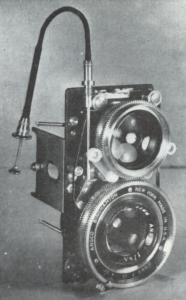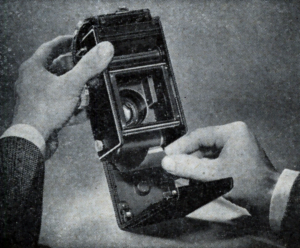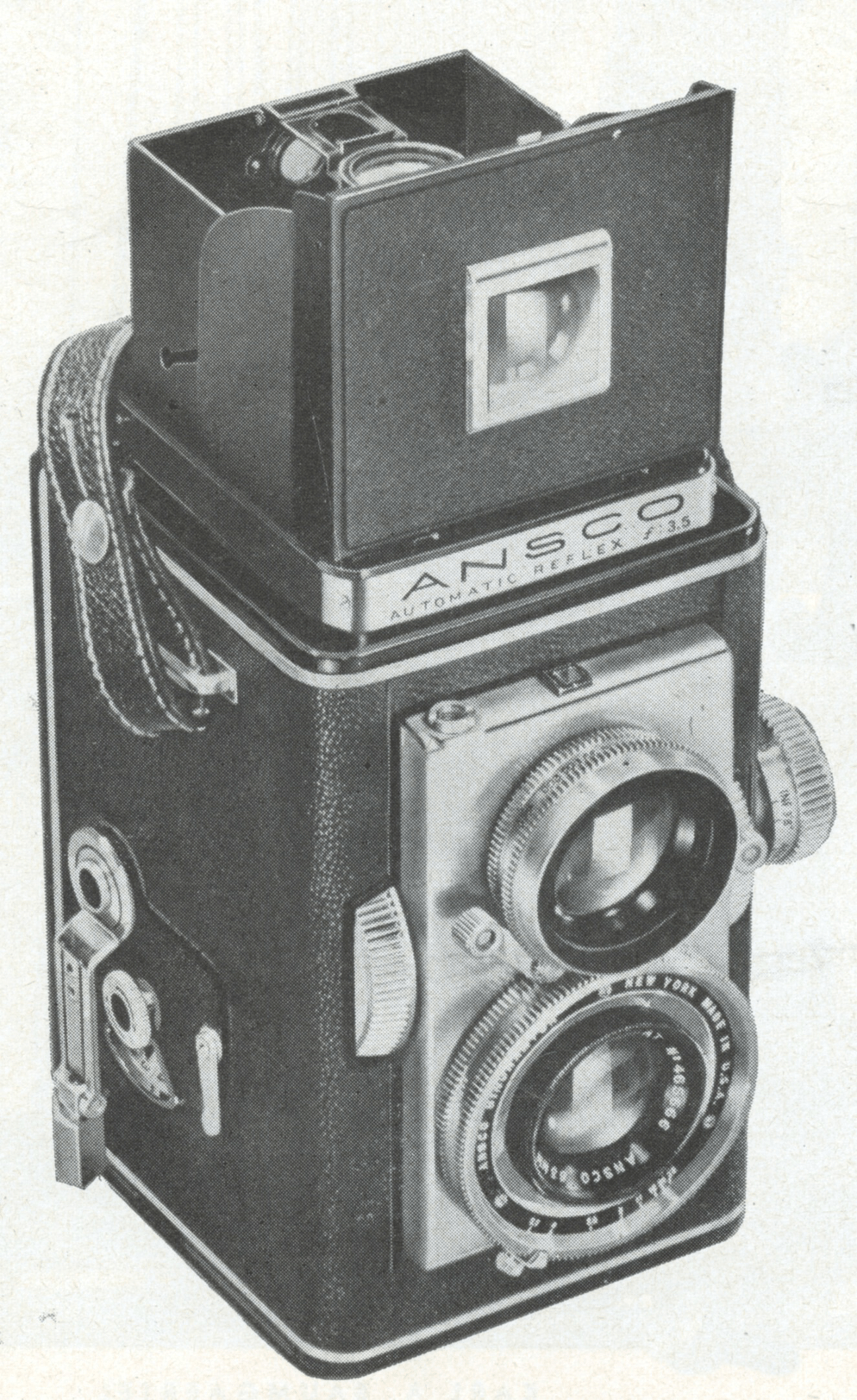By Dave MacFie
During the last decade the twin-lens reflex type of camera has skyrocketed in popularity with amateur and professional photographers alike. This has been due not only to the quality of pictures it produces, but also to the general excellence of design and construction of the original “Rollei” models, along with other quality imported cameras.
Foreign cameras, however, are not so plentiful as they once were, and it is doubtful if they will ever again be available in pre-war quantities at pre-war prices. Of the several American camera manufacturers who have designed twin-lens reflex cameras to fill the needs of amateur and professional photographers, Ansco has produced the most ambitious model to date.

The Ansco Reflex is a precision-built twin-lens reflex camera which takes twelve exposures 2¼x2¼” square on a roll of 120 film. With a chrome-satin on all metal parts and the body covered with black morocco grain leather, it is an attractive, compact camera measuring 3¼ x 4¼ by 5¾” in size. Completely assembled, its weight is 2 pounds, 12 ounces. (As compared with the average Rolleiflex, Ikoflex, etc., the Ansco Reflex is slightly larger and weighs 8 to 10 ounces more. — Ed.)
In addition to the usual advantage offered by reflex cameras — namely, ground glass focusing with all images appearing right-side-up the same size they will be in the negative, the Ansco Reflex features an automatic film transport and a device designed to prevent accidental double exposure. All controls and settings are visible from the normal picture-taking position so that shutter speed, aperture setting, and the focus can be checked without shifting the camera.
Structural Features

Eight non-shattering aluminum alloy castings form the basis for the Ansco Reflex Camera. These parts have been cast with such precision that they will remain assembled together even without using means of joining them.
A loose, wobbly lens panel has been one of the chief mechanical faults to develop in some types of reflex cameras. To insure the Ansco Reflex lens panel retaining its original alignment over a period of years, a precision-ground slider principle has been incorporated. The panel is suspended by four self-lubricating grooves, two on each side, and driven simultaneously by cams on both sides. A firm, four-point suspension assembly, and the elimination of torque, help make this type of mechanism resistant to wear. Although the cam and precision slide principle is more expensive than the rack-and-pinion mechanism, more commonly used, it is believed by the Ansco people that the advantages gained are worth the extra expense.

Gears and other moving parts in the camera are machine-cut to exact dimensions instead of being turned out on punch presses. Parts exposed to heavier strains and wear are hardened so that accuracy of all assemblies will be maintained. Bronze bearings have also been used wherever necessary to heighten the wearing qualities. Don’t strain your eyes looking for these bronze bearings because they are the proverbial “no see-’ums” — but they’ve been pressed into the aluminum alloy at strategic points to extend the life and dependability of the camera.

Another small but important feature lies in the safety catch locks on the spool stud supports. These locks make certain that the photographer cannot inadvertently disengage the spool from its supports while the camera back is closed. Since these locks are automatically released when the camera back is opened no attention need be given to them.
The Lens
Optical elements of the best quality have been used, and the lenses have been coated to reduce flare and internal reflections. A precise set-and-release shutter gives accurately measured speeds ranging from 1 second to 1/400 sec.
The taking lens is a coated Ansco f:3.5 Anastigmat, 83mm in focal length. An 83mm lens does not produce an abnormally shallow depth of field, yet it gives good coverage over the whole negative area right up to the corners. This is of particular interest to photographers who know the importance of getting top-quality over-all color transparencies.
The matched finder lens is an f:3.2 designed to provide greater brilliance of the reflected images on the ground glass focusing screen. There is further significance to the wider aperture of the finder lens than increased brightness of the ground glass; it also gives photographers a slight leeway for focusing errors, even at maximum aperture. lf focusing is accurate at f:3.2, it stands to reason that it will be correct for the taking lens, even when it is set at f:3.5. Both lenses are, of course, ground to exact formula and fully tested both before and after mounting. The entire lens assembly moves smoothly forward and back to take full advantage exact lens formula.
The taking lens is 33mm in diameter. Thus, any suitable accessories which this size of mount (such as Series VI adapter rings) may be used although accessories especially designed for the Ansco Reflex will soon be available.
The Automatic Film Advance

The automatic film advance is not coupled with the shutter cocking mechanism. Since it is a habit with most photographers to advance the film immediately following each exposure, the shutter springs would be held constantly under stress (save during the short intervals between tripping the shutter and advancing the film) if the Reflex film advance and shutter-cocking mechanisms were coupled to operate simultaneously. Placing the delicate shutter springs under prolonged tension has been avoided in order to make certain that the life and accuracy of the shutter will not be impaired.
Synchronization for Flash

Synchronization for flash photography presents no problem. The cable release socket at the top of the lens panel is connected by a direct drive shaft to the trigger level within the shutter. There is only one straight shaft with no linkages to complicate synchronization. Most standard types of flash guns, including high-speed electronic flash units as well as multi-flash, may be used on the new Reflex.
Operating Controls
The shutter speed is selected by rotating the barrel. This, in turn, rotates the mount of the finder lens so that the shutter speed being used automatically appears engraved on the top side. The aperture is set by moving a small lever at the bottom of the taking lens opposite the appropriate “f” number. An endless metal band under spring causes the selected aperture to appear in a small window located on top of the lens panel. As mentioned before, all adjustments are visible from the overhead view normally used in operating a reflex camera.

The Ansco Reflex can be loaded quickly. The camera back opens easily by pressing the two release buttons which are located near the top of the camera back. As the back opens, the safety catch locks on the spool supports are released.

“Bug” Hunting on the Ansco Reflex
Minicam’s Editors had the opportunity of testing one of the first Ansco Reflex cameras the assembly line. Each editor made individual tests and listed only his adverse criticisms of the camera. These criticisms were later correlated into questions and presented to Ansco’s Amateur Camera Department at Binghamton, N. Y. for answering.
The sole purpose in raising these questions was to Minicam readers a more complete picture of the Ansco Reflex. Minor adverse criticisms notwithstanding, the Editors are of the unanimous opinion that the Ansco Reflex is a excellent precision instrument.
Q. The Ansco Reflex has provisions for Bulb exposure, but no Time exposure. Why?
A. Time exposures could not be operated with the presently designed double exposure prevention device. For this reason, no time exposure appears on the shutter. It is, of course, possible to make time exposures with the time-bulb cable release that employs a knurled locking feature for time exposures.
Q. Why must two levers be used each time an exposure is made — one lever to cock the shutter, another to release it? Why not use one lever for both operations like some of the other reflex cameras incorporate?
A. This cannot be done without a radical redesign of the shutter. The single lever operation cannot be directly applied where means of double exposure prevention are supplied.
Q. The camera is covered with protruding knobs and is somewhat difficult to place in an accessories kit for this reason. Couldn’t some of these ratchets and knobs be fitted more closely to the camera body?
A. The advance ratchet and double exposure release are now placed so close to the body that they will rub the leather if operated carelessly. It should be noted that the focusing knob on the side of the camera can be removed and replaced with a large, flatheaded screw which we will supply. Focusing would then be done by rotating the two milled knobs at the front.
Q. Why are the lens gears exposed so openly? Isn’t this an invitation to grit and dust gathering?
A. This is a question of design policy. It should be noted that a number of other popular cameras incorporate open gearing. Open gears can be observed and will be cleaned oftener than those which are enclosed. It is impossible to make such entirely dust-proof.
Q. Are all the bugs ironed out of the double exposure release lever?
A. Through improper manipulation it is possible to “lock” any of the more elaborate cameras on the market today. The Ansco Reflex is no exception to this. A customer using this type of camera should thoroughly familiarize himself with the instruction manual and routine before operating the camera. We supply each camera with a dummy roll of film to facilitate this requirement.
(The double-exposure release seems to be extremely delicate. For us, with several different cameras, the works were suddenly “locked” for no reason we could fathom. Although clicking the double-exposure release instantly restored these cameras to normal operation, we felt that the double-exposure release was a little trick at times.-Ed.)
Q. Why doesn’t the center panel of the hood flip up out of the way for action shots sighted by eye? The brilliant view-finder, of course, is provided for this purpose, but isn’t it something more or less of an afterthought gadget?
A. It would have been much simpler and somewhat cheaper to supply a fame type finder, such as was suggested. The optical view finder, as furnished on the Ansco Reflex, is more expensive to produce and was definitely not provided as an afterthought. Its inclusion was the result of an extensive survey of qualified camera owners, the majority of whom requested the inclusion of this type of direct view finder.
Q. In focusing, the speed wheels have a desirable tension as the lens is racked away from the camera body. But there is little or no tension (drag) when the rack is moved back towards the camera body. What is the advantage of the free backward movement.
A. The model commented upon is obviously not in correct working order in this respect. There is tension on the lens rack movement at all times.
(Tests on later models substantiates this answer. — Ed.)
Although some critics have objected to the size and weight of the Ansco Reflex, Minicam’s Editors did not find these points objectionable, due, perhaps, to the fact that the camera is extremely well balanced.
MacFie, Davie. “The New Ansco Automatic Reflex.” Minicam Photography Feb. 1948: 30-35-137. Print.
